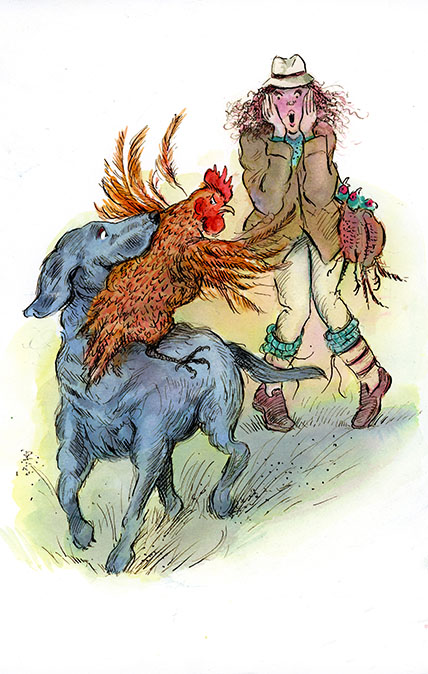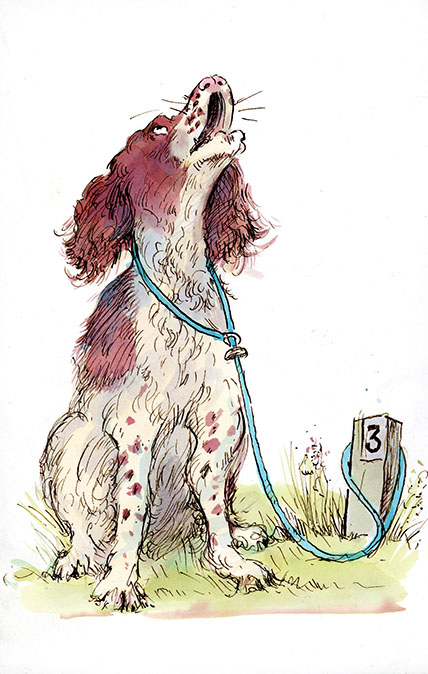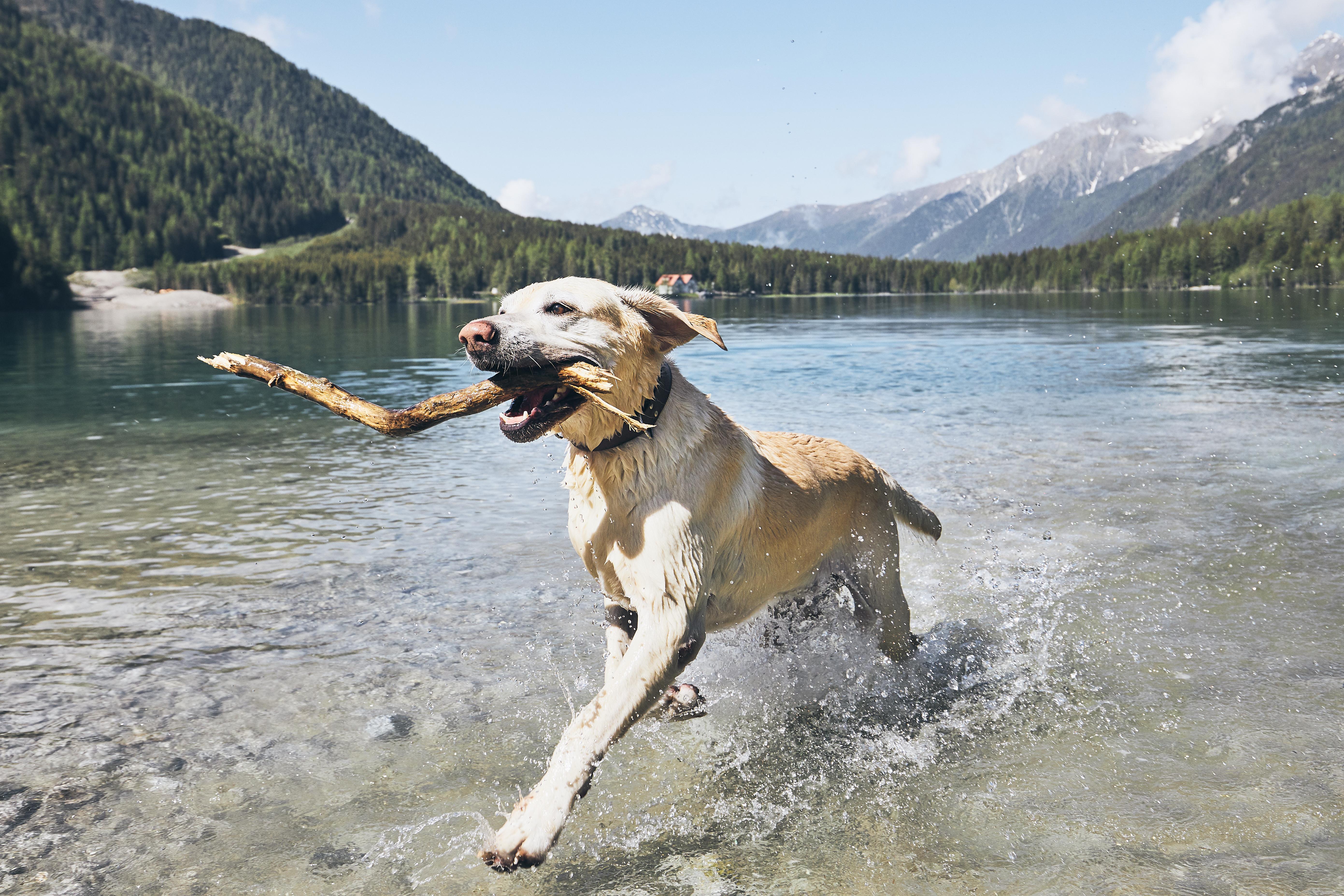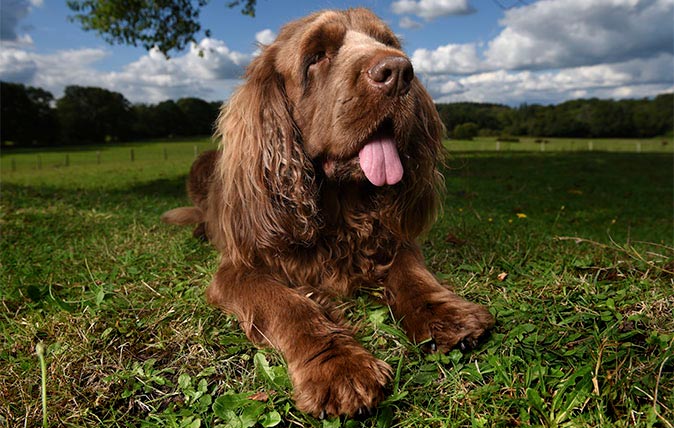Nightmare stories from some of the naughiest gundogs in Britain
Although everyone likes to think their gundogs are impeccably behaved, Rupert Uloth observes that they’re capable of letting us down in the most embarrassing ways in the field. Illustrations by John Holder.


When I saw the unusually tall land agent of a large York-shire estate arrive at a shoot with a wire-haired dachshund, I presumed his diminutive friend was just for company. However, when the hirsute little canine then followed his master to the peg, I could see the other guns, a dead-eyed duke among them, watching curiously. Presumably, this feisty furball was going to show everyone else how it was done. Or not.
As the duke brought down a stratospheric hen bird with a resounding thump, the dachshund saw this as the equivalent of the red lights going out at the start of a Grand Prix. He hared across the turf towards the inert quarry and settled down to tear great chunks out of the pheasant’s breast. The land agent was in two minds what to do, but, as the feathers drifted thickly in front of us like smoke on a battlefield, he threw down his gun and ran to admonish his wayward charge.

‘Running-in’ – the act of leaving the peg unbidden before the end of the drive – is an expression that was brought to the notice of the wider public by Lord Cranborne in the 1990s. He described his actions over the secret deal with the government to retain some hereditary peers in the House of Lords as the behaviour of an ‘ill-trained spaniel’. It resulted in his being sacked. I suspect the dachshund experienced a similar fate.
CLA Vice President Mark Tufnell, who’s successfully reintroducing wild grey partridge to his Gloucestershire farm, remembers taking his favourite spaniel on his father’s shoot with a new gamekeeper in charge.
‘I lost him on the first drive and he charged to the end of the wood, where the pheasants had concentrated, and proceeded to push them uncontrollably in great flurries over the guns to the extreme annoyance of the keeper, who was aiming to spread the birds evenly over a much longer period of time.’
Everyone who’s ever taken a gundog into the field will have tales of woe, even with breeds more recognised for retrieving, but, for some, the pleasure of shooting a bird and seeing it retrieved efficiently by their own dog is still one of the ultimate sporting experiences and worth the frustrations, humiliations and embarrassments that can occur.
'I think we’re probably just soft. They can drive you mad, but you have to give them a cuddle'
It’s a lot to ask of man’s best friend. The bustle of the day, with scores of beaters and dogs, the loud reports of the shotguns as they blast away and fallen birds landing within sniffing distance, plus others running off because they haven’t been cleanly killed.
Exquisite houses, the beauty of Nature, and how to get the most from your life, straight to your inbox.
All these factors make great demands on the discipline and self-control of a gundog, however highly trained. And there is considerable debate as to what a well-trained gundog actually is.
‘You get some keepers who house their dogs in kennel from day one,’ points out Johno Newton, head keeper on the Goodwood estate near Chichester in West Sussex. ‘When you see them in the field, they’re like Velcro, stuck to their master’s side and they don’t make a mistake, but, when you look into their eyes, there’s nothing there,’ he explains as he ruffles the neck of his black labrador, Boris, while we talk around the kitchen table.

‘There’s nothing wrong with training them that way. I think we’re probably just soft. They can drive you mad, but you have to give them a cuddle.’
Nevertheless, Boris is clearly the kind of gundog that most guns dream about. Mr Newton admits that it’s easier for him as Boris and his younger labrador, Bolly, are exposed to the keeper’s life every day: sitting in the footwell while the pheasants are fed, pushing pheasants back to the pens in late summer and doing dummy work as they go about their business.
For those whose jobs keep them in the city, gundog ownership is more challenging and often with unpredictable results. ‘My flatcoated retrievers are sub-contracted to my wife, who doesn’t shoot,’ explains Canice Hogan, a former Goldman Sachs banker, who now runs his own recruitment company based in London, but requiring regular travel to New York. ‘As a result, they’re very good at walking to heel, picking up tennis balls and barking at Ocado deliveries.
‘They look very handsome, but I have to admit that their focus on the etiquette of gamebird retrieval is lacking. However, the fact that they pick up other people’s birds means that some people might be fooled into thinking I’m a decent shot.’
According to former Cazenove investment-bank chairman Tim Wise, there are two ingredients that will ensure a successful gundog: breeding and training. He and his wife, Judith, have had two working cockers that have been at opposite ends of the spectrum. ‘Our old dog was a real mutt in terms of bloodlines, untrained and a psycho around pheasants,’ admits Mr Wise.

The first time he took her out was with his boss at his rather smart shoot in Hampshire. When he let the dog off after the first drive, she took off across the field and disappeared over the horizon, finally returning just before lunch.
‘Shortly after, at a friend’s shoot, I realised that she was no longer with me and birds were pouring out of the woods,’ he adds. ‘Then, I heard across the keeper’s walkie-talkie: “There’s a black-and-white dog in the woods. It’s destroyed the drive”.
‘She has a special place in the “Hall of Shame” at the ever-tolerant Goodwood, but we actually had a lot of fun and my shooting and her gundog skills were a good match. We had a pact of “what happens on tour stays on tour”, but Judith stayed away – she found the endless horror shows too excruciating.’
The Wises’ second dog, Bo, is very different – ‘she’s from proper working stock and we’ve done some training with the help of the marvellous Julie Elborough,’ elaborates Mr Wise. ‘It’s transformed Judith’s attitude to a day’s shooting as the dog is very much hers.’
'One keen shot I spoke to still cringes at the memory of the time his chocolate labrador impregnated a very good friend’s superb spaniel'
Mrs Wise took Bo, still only one year old, out a few times last season, with Miss Elborough helping. They started well behind the line and did some rudimentary picking-up. ‘By the end of the season, she had a few drives at the peg when she was completely calm – a rather strange experience for us,’ says Mr Wise with a smile.
‘For Judith, the thrill of working a dog and seeing it respond has been enormous. However, disaster is always just around the corner and we expect it all to go horribly wrong this season.’
For William Tyrwhitt-Drake, who runs incomparable partridge shoots on his 2,500 acre Bereleigh estate at East Meon in Hampshire, the important thing about a gundog is that it must be a good pet and be happy to live in the car overnight when shooting away from home.
One of his dark golden retrievers, named Rock, after the Cornish village, was out of control in what he calls ‘long dog’ mode, looking for female company. Once, he disappeared across Polzeath beach, tearing through hundreds of holiday-makers up the steps to New Polzeath and into the village.
Some people prefer bitches for this reason, but there’s a risk there, too. One keen shot I spoke to still cringes at the memory of the time his chocolate labrador impregnated a very good friend’s superb spaniel, which required a caesarean, from which the bitch died.
However, disaster can befall even the most experienced. Simon Lester was keen to make a good impression when he was appointed head keeper on the Earl of Leicester’s Holkham estate in Norfolk in 2001: ‘My first duck flighting evening proved to be a dog nightmare. Having moved to Norfolk from a very busy 70-day a season shoot in the Midlands, my dogs were well-honed, fit and keen.
‘The night started well, with a good selection of wild duck coming in to the flight pond, and the two guns billeted to our pond shooting well,’ he recalls.
‘As darkness began to descend, the flight ended with a crescendo of teal plip-plopping into the gloom. When it was time to pick up, I let my dogs out of the Land Rover and noticed one of my spaniels, Dewi, was hugging my boots and wouldn’t leave me. It turned out he was afraid of the dark.

‘My other spaniel, Jack, worked well picking up ducks from the edge of the pond. However, when it was time to collect the birds on the water, he jumped in with a great big splash, but remained vertical, flailing his front legs with a very worried look on his face – he couldn’t swim.
‘My third dog, Boot, a labrador, spent most of the time swimming around in circles retrieving rats and moorhens. Luckily, beatkeeper Martin Joyce’s super spaniel, Jasper, saved the day.’
If it all goes well and you end up with a dog that can do no wrong, the sky’s the limit. Before Boris gets too old, Mr Newton intends to train him on truffles.

The Labrador: The world’s favourite dog
Ben Fogle traces the illustrious history of the world’s favourite dog, the Labrador.

Credit: John Millar/Country Life
The top ten British dog breeds that need saving and quickly
French bulldog wins top spot over labrador as some of the most quintessentially British breeds are pronounced 'vulnerable' by the

Credit: Jake Eastham
How to get the best out of your day's shooting
Ensure you’re invited back with our advice on peg etiquette, choosing the right gun and the joys of rough shooting.

The Italian Greyhound: Tiny, beloved of royalty and anything but fast (until they put their minds to it)
Italian Greyhounds are a conundrum: for all their speed potential they're usually infuriatingly slow, miniature-sized – and they're not even
